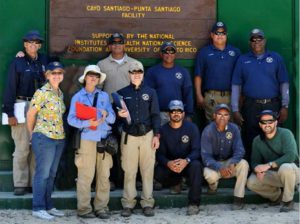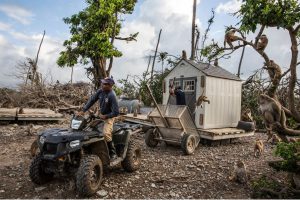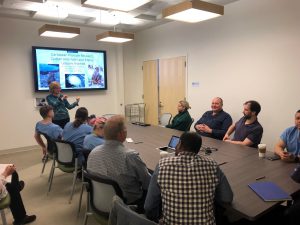Mid-September of 2017 marked a horrific tragedy with the now infamous Category 5 Hurricane Maria. According to the National Oceanic and Atmospheric Administration (NOAA), Maria was worst natural hurricane in nearly 90 years for Puerto Rico and was also the deadliest Atlantic hurricane since Jeanne in 2004. It was the costliest in Puerto Rico history.

Dr. Melween I. Martinez is a Professor at the University of Puerto Rico – Medical Sciences Campus. More importantly for this story, she is the Director of the Caribbean Primate Research Center and the Animal Resources Center (CPRC). As such, Dr. Martinez was the individual thrusted into the command role in the disaster-relief and recovery operations. In the aftermath of the storm, she appealed to the National Institutes of Health for help.
“The NIH [Office of Research Infrastructure Programs] arranged a conference call and I was on the line with all of the NPRC directors. I remember being so overwhelmed that I just sat on the grass because that was the only place that I had reception. I kept telling them that I’m going to talk as fast as I can, just in case this call was dropped,” Dr. Martinez said.
She continues to describe the conversation, “And they just asked me what we needed. I guess that is when I told them about the roof (water collection) and that we didn’t have communications, but that the animals were fine. We were very concerned with getting this repaired, because on Cayo Santiago, the only source of water comes by collecting rain water. I think I gave them as much information as I could. The important part of that call is that everybody had a connection with us before they all began to send supplies to us,” she said.
In the words of WaNPRC Director Mike Mustari from October of 2017, “The challenges faced by our colleagues at the Caribbean Primate Research Center (CPRC) in Puerto Rico have reminded us of how fortunate we are. The enormous damage caused by Hurricanes Irma and Maria across all of Puerto Rico continue to impact most aspects of daily life. These severe storms also leveled the CPRC. All NPRCs came together to provide financial, veterinary supplies, personal items and human resources to help with the initial phase of recovery.”

“The first things we received came from the NPRCs, the various PIs, and the Better Research Better Life Foundation. These three groups got together, and with the funds that you all collected, you were able to buy the stuff we needed. This included the lumber that we needed to rebuild the water collection system on the roof. The ATVs that were sent were very useful because we needed to move and there were so many downed trees on the island and we needed a way to move in order to scatter food in different areas.”
The items and personnel first arrived at Sabana Seca, which is home to the CPRC field station, 30 minutes west of the capital of San Juan. “We needed to get two additional vehicles to move all of the equipment and supplies that was going to Cayo Santiago,” said Dr. Martinez. That is the small island, about ½ mile off of the eastern coast of Puerto Rico, which is home to about 1700 free-roaming Rhesus monkeys, also known as Monkey Island.
Fast forward to this past April when Dr. Martinez came to Seattle as the keynote speaker for AALAS District 8 Annual Meeting. WaNPRC staff were treated to a sneak preview of her presentation, “Caribbean Primate Research Center and Hurricane Maria: Lessons learned.” This talk included many slides showing the devastation.

Cayo Santiago was once a very active research site, hosting a variety of genetic and behavioral studies conducted by professors and their graduate students from around the world. Today, the rhesus monkeys that survived Maria are now helping researchers learn more about the response to the traumatic stress caused by the storm’s destruction. This is explored in Luke Dittrich’s May 14, 2019 story in the New York Times entitled, “Primal Fear: Can Monkeys Help Unlock the Secrets of Trauma?”
Learn more about the history of the CNPRC and Cayo Santiago: American Journal of Primatology
Learn more about ongoing research on surviving trauma on Monkey Island: NPR On Point
Message from Dr. Melween Martinez, CPRC Director